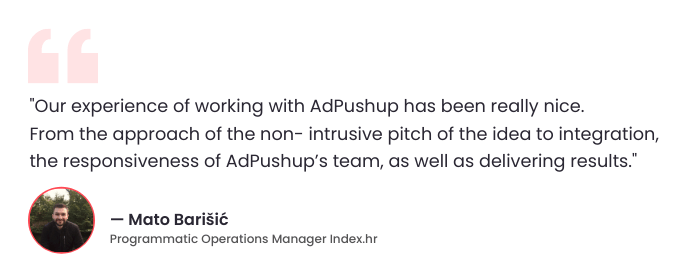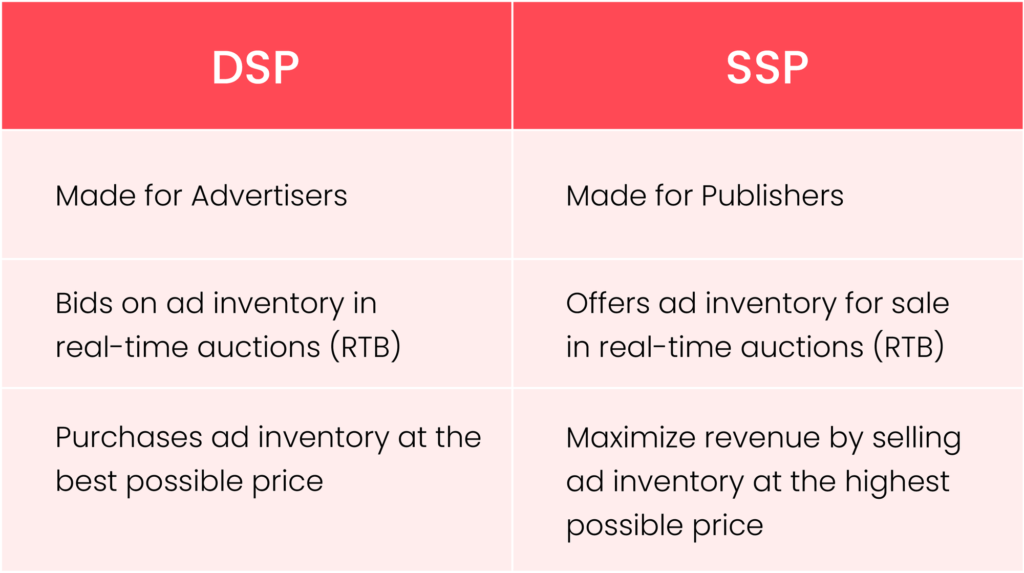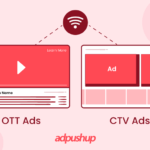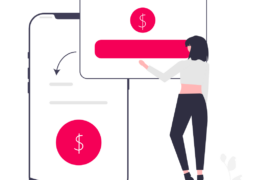Dive into the differences between DSP and SSP to enhance the potential of your digital advertising. In this DSP vs SSP guide, we’ll discuss how each platform functions, their unique advantages, as well as their correlation between DMPs, Ad Exchanges, and more.
As we step into the world of programmatic advertising, we come across plenty of jargon that can be quite difficult to understand. At the heart of this complex ad tech ecosystem lies DSP and SSP. These two key players are often shrouded in mystery.
Apart from DSP and SSP, another of the most prominent and regularly occurring terms in ad tech is DMP (Data Management Platform). They all work as efficient tools and are used by advertisers and publishers to optimize their gains in a bustling marketplace.
So, if you are perplexed over what is DSP, what is SSP, how they differ, and what role a DMP plays, this blog is just what you need. So, without further ado, let’s get started.
Understanding the Difference Between DSP and SSP
Is DSP and SSP same? Let’s find out,
Simply put, DSP (Demand-Side Platform) caters to advertisers who want to buy ad spaces from web publishers’ inventory. The term “Demand” in Demand Side Platforms refers to the advertisers and agencies seeking to buy publishers’ ad inventory to promote their products/services online.
On the other hand, SSP (Supply-Side Platform) caters to publishers who want to sell their ad inventory. The term “Supply” in Supply Side Platforms refers to the websites and apps that offer their ad spaces to advertisers.
Now that we know which platform serves which side—advertisers for DSPs and publishers for SSPs—it’s important to note that there are many more differences between them.
But before we delve into the specifics of DSP vs SSP or compare their features and benefits, let’s first understand what each of them actually is.
What is a DSP (Demand Side Platform)?
So, what does DSP stand for in advertising? DSP refers to Demand Side Platform, a software program or tool allowing advertisers to purchase ad space or media from publishers to fulfil their advertising demand.
DSPs use automation throughout the whole process to buy ad impressions for advertisers at the most competitive prices possible through ad exchanges.
What is an exchange?
An ad exchange is a marketplace where advertisers and publishers can buy and sell ad inventories, such as display ads, video ads, and mobile ads. The whole process of buying/selling is executed through real-time bidding, which ensures the highest bidder wins the auction and displays their ad on the publisher’s website.

How Does DSP Work?
Understanding how a Demand-Side Platform (DSP) works is essential to get hold of the intricacies of programmatic advertising. So, basically, it consists of five steps mentioned below:
- Step 1: The user will visit your website.
- Step 2: The information about this user is stored in a DMP (Data Management Platform), which is connected to the DSP and sends the data to the ad exchange.
- Step 3: It uses the user data based on demographics, behaviour, location, and device type and comes up with the most valuable ad impressions for the advertiser.
- Step 4: The DSP participates in an auction to bid on the available ad space in real-time, based on the advertiser’s targeting criteria and budget.
- Step 5: The highest bid wins the ad placement, and then, finally, the ad is served and shown to the users.
What are the Benefits of DSP (Demand Side Platform)?
A Demand-Side Platform (DSP) proves to be an invaluable platform for advertisers, offering a range of powerful benefits:
1. Helps in Reducing Ad Rates
DSP allows advertisers to access a wide range of ad inventory at competitive prices. As mentioned earlier, demand-side platforms utilize real-time bidding to buy ad placements. The real-time bidding (RTB) process can potentially lead to lower costs for advertisers, especially when there’s less competition for a particular ad slot. How? It dynamically adjusts bid prices based on real-time competition and targeted audience relevance.
2. Works Quickly and Efficiently
As the whole process is automated, advertisers can purchase ad inventory in milliseconds, which eventually helps ad campaigns to be launched and optimized swiftly.
3. Offers a Huge Inventory
DSPs help advertisers connect with a global network of publishers and save time and effort in discussing terms with many publishers. Advertisers only communicate with a single provider, DSP, and explore all available options.
4. Provides Accurate User Targeting
DSPs are highly effective in precise ad targeting. By collecting data from multiple sources—such as demographics, behaviour, location, and device type—DSPs enable the creation of highly targeted ad campaigns.
5. Provides Useful Analytics
Lastly, DSPs allow advertisers to understand the campaign’s performance with the help of comprehensive analytics and reporting tools. Using DSPs, advertisers can track impressions, clicks, conversions, and ROI in real-time, which further helps in improving future results.
Demand Side Platform Examples
When it comes to a list of the best DSPs in the ad tech industry, companies like Google Display & Video 360, Xandr, MediaMath, and Adobe Advertising Cloud will always find a spot. These renowned platforms make for a great example of a demand-side platform. However, there are a lot more DSPs out there offering different features and functionalities.
Some of these platforms combine DSP and SSP, and some even integrate DMP (Demand Side Platform) with these two platforms to maintain efficiency and transparency for advertisers to manage their advertising operations.
Now that we are well-versed in demand-side platforms, let’s delve deeper into DSP vs. SSP and discuss the SSP meaning in advertising and how it helps publishers.
What is SSP (Supply Side Platform)?
SSP or a Supply Side Platform is a software program publishers use to manage, sell, and optimize their ad inventory. In fact, according to Statista, a survey carried out on US publishers found that the publishers, on average, use around 5 SSPs together to enhance their ad revenue.
Simply put, these platforms help publishers streamline and optimize the ad-selling process.
SSPs connect publishers with various ad exchanges, DSPs, and ad networks simultaneously. This allows publishers to serve a large set of buyers and boosts revenue effectively.
Moreover, supply-side platforms are becoming more and more popular among publishers.
The global supply-side platforms market is experiencing rapid growth, with projections indicating a Compound Annual Growth Rate (CAGR) of 20.20% from 2023 to 2028.
How Does SSP (Supply Side Platforms) Work?
To understand the process, you can go through the following steps:
Step 1: A publisher integrates their app or website with SSP to manage and categorize ad spaces.
Step 2: When the user visits the publisher’s site or opens the app, an ad request is sent to the SSP, which contains all relevant information (demographics, behavior, and browsing history).
Step 3: The SSP sends the ad request to multiple ad exchanges and DSPs.
Step 4: The user data is analyzed by the DSPs, and a bid is placed in the available ad space in real-time.
Step 5: The SSP selects the highest bid from the auction and places the winning ad on the publisher’s site or app.
Step 6: The winning ad is delivered to the user in real-time.
Apart from this, the SSPs also provide detailed reports and analytics to the publisher that help them optimize their inventory and pricing strategies for future ad placements.
What are the Benefits of SSP (Supply Side Platform)?
Now, you must be wondering what does SSP do and how it drives revenue growth for publishers. Let’s have a look.
1. Automated Ad Selling
Automated ad selling is one of the most essential benefits offered by SSPs. It selects the most desirable buyer in terms of bid pricing and ad quality standards from the available bids. This makes the process more efficient and less time-consuming for publishers.
2. Access to Diverse Ad Networks
SSP provides publishers with a vast network of ad exchanges and DSPs to increase the chances of selling ad space quickly and at competitive rates, which enhances overall profitability.
3. Optimized Inventory Control
SSP comes with a wide array of effective tools, such as floor price management, ad format optimization, etc. These features further help publishers optimize their ad inventory and accelerate ad revenue growth.
4. Adjustable Pricing Thresholds
Returning to floor price management, it’s a crucial feature provided by SSPs, allowing publishers to maintain the value of their ad inventory. This also prevents their ad spaces from being underpriced.
5. Ad Frequency Regulation
SSPs enable publishers to control the frequency of ads shown to users, which enhances the user experience by preventing ad fatigue.
Supply Side Platform Examples

Some of the most common examples of SSP we can provide include platforms like Google Ad Manager, OpenX, Xandr, Magnite, and PubMatic. Google Ad Manager stands out as the most popular SSP as it integrates with Google’s ad ecosystem and provides publishers with the required tools to manage ad inventory and optimize revenue. Much like DSPs, there are a lot more examples of DSPs or platforms of DSPs, each designed to meet the specific needs of publishers.
Having established what is DSP and SSP in programmatic advertising, let’s shed a light on some of their differences.
Critical Differences Between SSP and DSP (DSP vs SSP)
If we look at the broader picture, demand-side platforms help advertisers buy ad space efficiently, while supply-side platforms help publishers sell their ad space at the best price. But there’s a lot more to it, so let’s look closer at DSP vs SSP stand-off.
User Base
First of all, there’s a clear difference in end users. Marketers and advertisers use DSPs to get the most out of their ad campaigns. Meanwhile, SSPs are used by publishers who want to sell ad space to advertisers at the best possible price.
Primary Focus
The primary focus of an SSP is to help publishers sell their ad inventory across various ad exchanges. And, the primary focus of a DSP is to help advertisers buy the required advertising space and target the right audience base.
Optimizing Ad Campaigns
DSPs enable advertisers to optimize their ad campaigns by allowing them to manage and purchase ad inventory across multiple channels in real-time. In addition, this process even comes with advanced targeting options that ensure that the ads are shown to the most relevant audiences, eventually maximizing the return on investment (ROI) for advertisers.
On the other hand, SSPs help publishers maximize their ad revenue by offering a vast network of multiple ad networks, ad exchanges, and DSPs simultaneously. SSPs manage and optimize the available ad space, enabling real-time bidding (RTB) and ensuring that publishers receive the highest possible bids for their ad impressions.
Here’s a quick summary of DSP vs SSP.
Supply Side Platform vs Demand Side Platform – Differences at a Glance
In case the differences between a supply-side platform (SSP) and a demand-side platform (DSP) were a bit complex to understand, here are the primary differences in brief.

What are the Similarities Between DSP and SSP?
Delving deeper into the DSP vs SSP, let’s now look at the similarities that both SSP and DSP share.
1. Common Goal
The users of these platforms ultimately have the same goal – increasing the efficiency of their advertising activities. DSPs are for marketers and advertisers looking to find a platform that will give them the ad inventory supply and functionalities to control their ads. SSPs are for publishers whose main purpose is to sell ads at the best price level to the demand side.
2. Real-Time Bidding (RTB)
Both DSPs and SSPs participate in real-time bidding (RTB), a process that allows advertisers to bid on ad impressions as they become available. As previously discussed, RTB ensures that the highest bidder wins the ad placement, which benefits both parties.
3. Automation
Both DSPs and SSPs are based on the same core feature: Automation. These software programs use sophisticated algorithms and technology to automate the buying and selling process. This reduces the need for manual intervention and makes the entire process faster and more efficient.
4. Integration with Multiple Platforms
Both DSPs and SSPs integrate with multiple ad exchanges, networks, and other platforms. This integration allows for a more extensive reach, a greater pool of ad inventory for advertisers, and more ad-selling opportunities for publishers.
5. Analytics and Reporting
DSPs and SSPs can assist their users effectively by providing comprehensive analytics and reporting tools. These tools help advertisers and publishers understand the performance of their ad campaigns and inventory.
Now that you have got the hang of DSP vs SSP, let’s check how this duo works together to deliver ads.
How Does DSP and SSP Collaborate?
It may seem like a DSP vs SSP standoff, but that’s not really the case. While SSP caters to the publishers, DSP caters to the advertisers in the programmatic advertising space.
On one side, we have DSPs, which allow advertisers to buy ad space and reach their target audience. On the other hand, we have got SSPs, allowing publishers to sell ad space and generate ad revenue.
Ultimately, it’s a delicate balancing act to ensure advertisers and publishers get the best possible deal.
Now that we are through DSP vs SSP, let’s turn our attention to Ad exchanges and see how they fit into the picture.
DSP vs SSP vs Ad Exchange
Is SSP the same as an exchange? How does an ad exchange correlate with SSP and DSP? Let’s explore the connections.
As mentioned earlier in the blog, ad exchange is a marketplace for publishers and advertisers. Think of it as a collaboration point or a crossroad where publishers and advertisers meet.
The ad exchange is where the auction is held for the ad impressions. This auction involves advertisers bidding on the publishers’ ad space with real-time bidding protocol.
Publishers offer their ad space through SSPs, while advertisers compete for impressions via DSPs. The ad exchange then selects the winning bid, and the corresponding ad is served to the user.
If you have made it this far in the blog, we believe you’ve got a good handle on SSP vs DSP and how a DMP falls into the picture. Let’s now shed light on the DMP (Data Management Platform) and see how it fits in the programmatic supply chain.
Another frequently asked question in the industry, especially among newcomers, revolves around the differences between DSP vs SSPs vs DMPs. Let’s explore whether a DMP works in opposition to or in tandem with DSPs and SSPs.
What is a Data Management Platform (DMP)?
A Data Management Platform (DMP) is a software program that collects, organizes, and analyzes large data sets for DSPs and SSPs. This is done so that the received data can be matched perfectly with the target audience.
In addition, DMPs are essential for marketers and advertisers as they enable the integration of first-party, second-party, and third-party data to enhance operations in the programmatic supply chain.
Apart from that, DMPs also facilitate data-driven decision-making, helping publishers and advertisers optimize their marketing efforts and achieve better returns on investment.
How SSPs, DSPs, and DMPs Fit into the Programmatic Advertising Ecosystem?
All of these platforms complement each other and pave the way for seamless programmatic advertising. While SSP helps publishers sell their ad inventory, and DSP helps advertisers buy it, DMP (data management platform) stores valuable data that advertisers use to improve targeting and segmentation.
So, think of it like this: SSPs and DSPs handle the buying and selling, and DMPs provide the insights that make those transactions more effective.
Key Takeaways
- DSP (Demand-Side Platform) caters to advertisers who want to buy ad spaces from web publishers’ inventory.
- SSP (Supply Side Platform) caters to publishers who sell their ad inventory to advertisers, ad agencies, etc.
- Instead of viewing it as a “DSP vs. SSP stand-off,” we should look at their complementary roles in facilitating efficient ad transactions.
- Ad Ad exchange is the digital marketplace where DSPs and SSPs interact to buy/sell ad inventory in real-time through real-time bidding technology offered by ad exchanges.
- DMP (Data Management Platform) is the data brain behind SSP and DSP. A DMP collects, analyzes, and activates data to enhance the ad buying/selling process.
Frequently Asked Questions: DSP vs SSP
DSPs and SSPs are designed to serve different players within the ad tech ecosystem, so viewing them as competitors (DSP vs SSP) is a misconception. They both come with an entirely different purpose.
Advertisers use DSP (demand-side platform); it connects advertisers to multiple ad exchanges, allowing them to buy the best possible ad impressions at competitive prices.
SSP (supply side platform) is used by the publishers. It connects publishers to multiple DSPs, ad exchanges, and ad networks, enabling them to sell their ad inventory and earn revenue.
There are plenty of supply-side platforms out there to choose from. Some of them are:
– PubMatic
– AppNexus
– Sharethrough
– OpenX
But, before choosing a supply-side platform, publishers should consider certain factors. This includes evaluating the SSPs’ relationship with demand partners, finding a reliable header bidding solution, determining brand safety, cost, and the list goes on.
Google operates as both DSP and SSP. It comes with different platforms for both the advertisers and publishers. For advertisers, Google offers “Google Ads”, formerly known as Google Adwords, which is a DSP.
For publishers, Google offers “Google Ad Manager”, enabling publishers to sell their ad space. A renowned SSP provided by Google is “Google Adx”, which was formerly known “Doubleclick Ad Exchange”.
DSPs and SSPs are not types of ads themselves but rather complementary platforms that enable programmatic advertising. Advertisers use DSPs to buy ad space and target audiences effectively, while publishers use SSPs to sell their ad inventory at the best possible prices through various ad exchanges and networks.
Yes, Google Ads is a DSP. But it’s not quite like other demand-side platforms. With Google Ads, advertisers can only purchase traffic or ad impressions from Google’s own inventory. In contrast, other DSPs typically allow advertisers to buy ad impressions from various suppliers and sources.
In simple words, both DSP and SSP facilitate the ad buying/selling process. Thus, they should not be perceived as competitors but rather looked at as collaborative partners, making programmatic advertising seamless.

Deepak has a keen eye for detail and a deep understanding of the ad tech landscape. Whether it’s through in-depth articles, thought-provoking insights, or compelling storytelling, he’s dedicated to helping people navigate the complex world of ad tech with the simplicity of his words.







